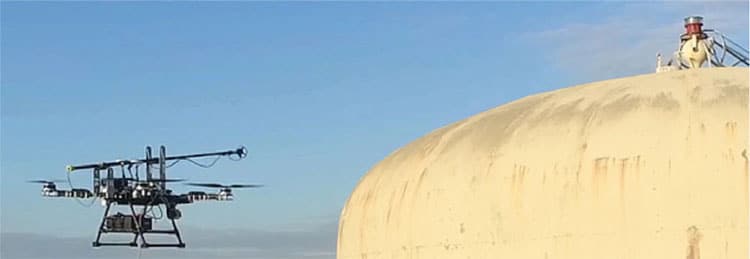By Victoria Scarborough, Ph.D., The ChemQuest Group
For decades, original equipment manufacturers (OEM) have used specially designed robots to paint automobiles, all types of parts, and heavy equipment in a factory environment. To accommodate customer needs, coating chemists have created multiple coating formulas and techniques for each robot and the corresponding substrate. This helps address robotic painting problems on the OEM factory floor. As software expertise has grown, so too have robotic capabilities that expand to painting outside the factory environment. Now, paint bots and drones are currently at the cutting edge of paint application technology.
In 2019, AkzoNobel held its annual Paint the Future contest, seeking new technologies to fund for collaborative development. The contest was won by Apellix LLC, a startup company in Jacksonville, FL, whose patented tethered drone technology was developed not only for painting structures, but also for measuring dry film thickness on the substrate. The technology has sophisticated algorithms that allow it to build a surface “heat map” to tell the asset owner where paint is too thin and may fail prematurely. In addition, the drone can also be used for cleaning surfaces prior to painting.
Another robotic painting tool is being developed by HausBots Ltd, in the United Kingdom. Here, the HB1 robot is shown climbing rough surfaces and can overcome obstacles such as wires and bolts. The robot is used for painting and doing visual inspections of a building. It sticks to the surface using suction and can climb up to about 100 feet. In 2021, the HausBots staff was recognized by BuildWorld as some of the best new talent designing robotics for the built environment. In addition, HausBots has been selected to conduct a trial of its innovative wall climbing robot for the removal and prevention of graffiti on highway roads by Highways England.
Transforma Robotics Pte. Ltd. is located in Singapore and sells a line of robotic painting devices. The PictoBot is an autonomous system developed for industrial applications. It can paint large wall sections using a typical spray nozzle to apply paint to building interiors. According to Transforma, there is a 25% time savings over using two painters for the same job. It reaches up to 30 feet inside and can easily paint high walls and ceilings using its extendable and retractable spray nozzle arm. It stores about 10 gallons of paint. Transforma also sells a line of robots for exterior use and one that uses electrostatic spray to dispense disinfectants.
While some of these technologies are in the early stages of development, the benefits of using drones and paint bots are evident, especially when it comes to improving worker safety. Commercial painting often involves the use of scaffolding and ladders in elevated positions that puts workers at greater risk. If painters can stay on the ground and monitor the drone’s performance, they face fewer hazards.
Drones could apply paint in enclosed spaces such as mixing tanks that usually require special breathing equipment due to exposure to hazardous fumes. In a time when skilled labor is scarce, robots can perform repetitive tasks, which allows experienced workers to focus on more complicated painting duties. Making painters more efficient at their work will reduce the overall cost of jobs and optimize the painting process.
About the author: Victoria Scarborough, Ph.D., is vice president, collaborative innovation, at The ChemQuest Group, Inc., and ChemQuest Technology Institute. Email: vscarborough@chemquest.com and phone: 330-998-5483.
